Kesko Bundle
How Well Do You Know Kesko?
Kesko, a powerhouse in the Finnish retail landscape, isn't just a company; it's a cornerstone of Northern European trade. With a vast network spanning multiple countries and a diverse portfolio of retail operations, understanding the Kesko SWOT Analysis is crucial. Its influence extends across grocery, building and technical, and car trade sectors, making it a key player for investors and industry watchers.
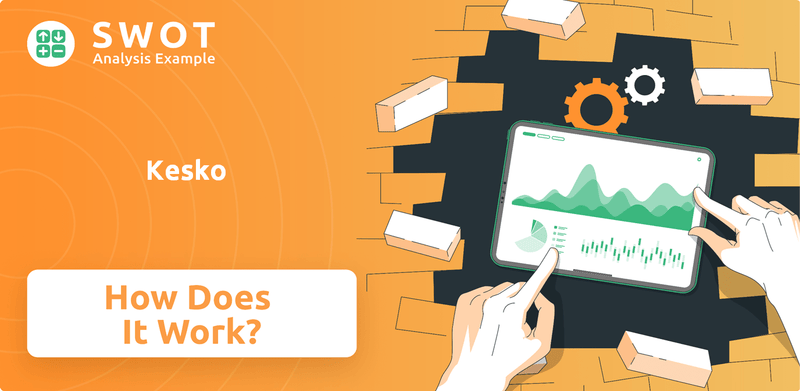
This exploration of the Kesko company dives deep into its operational strategies, revealing how it generates value and maintains a strong market presence. We'll uncover the Kesko business model, examining its three core divisions and its commitment to sustainability. Whether you're interested in Kesko operations, its financial performance, or its expansion strategies, this analysis offers valuable insights into one of Finland's leading companies. Learn about Kesko structure and Kesko services to understand how it navigates the complex retail environment.
What Are the Key Operations Driving Kesko’s Success?
The Kesko company creates value through its diverse operations across three main areas: grocery trade, building and technical trade, and car trade. This diversified approach allows Kesko to serve a broad customer base and mitigate risks associated with economic fluctuations in any single sector. The company's structure supports a blend of centralized management and local operational flexibility, enabling it to tailor offerings to specific market needs while leveraging its scale.
Kesko's business model emphasizes a strong retailer partnership in the grocery segment, efficient logistics, and strategic acquisitions to enhance its market position. The company's operations are supported by a robust supply chain, strategic partnerships, and an extensive store network that is increasingly integrated with online sales and digital services. This integration enhances the customer experience and supports Kesko's growth strategies.
Kesko's commitment to sustainability and corporate social responsibility further enhances its value proposition, attracting environmentally and socially conscious consumers and investors. This commitment is reflected in its operational practices and strategic initiatives, contributing to its long-term success and positive impact on the community.
The grocery trade segment includes retail chains like K-Citymarket, K-Supermarket, and K-Market. This division benefits from a unique retailer model that combines centralized buying and supply chain management with local insights. This model allows for tailored offerings that meet specific local demand and preferences.
This segment, encompassing brands like K-Rauta and Onninen, offers a wide range of products and services for both consumers and professionals. Operational processes involve sourcing and logistics to ensure efficient distribution. Recent acquisitions, such as Davidsen in 2024 and Roslev Trælasthandel A/S in 2025, strengthen Kesko's market position in Northern Europe.
The car trade division, through K-Auto, handles the import, retail, and after-sales services for brands like Volkswagen and Audi. This segment offers new and used cars, along with associated services. The division's operations are supported by a strong supply chain and an extensive store network.
Kesko's value proposition is built on a diversified business model, strong market positions, and a commitment to customer service and sustainability. The company's ability to maintain profitability across diverse markets highlights its effective operational processes. The company's strategic focus on digital services enhances the customer experience and supports its growth.
Kesko's operations are characterized by a strong emphasis on efficiency, customer service, and strategic expansion. The company's diverse portfolio and retailer-focused approach allow it to adapt to market changes effectively. Kesko's financial performance reflects its robust operational strategies.
- Kesko operates in the grocery, building and technical, and car trade sectors.
- The grocery segment uses a unique retailer business model.
- The building and technical trade segment focuses on acquisitions to expand its market presence.
- The car trade division handles import, retail, and after-sales services.
Kesko SWOT Analysis
- Complete SWOT Breakdown
- Fully Customizable
- Editable in Excel & Word
- Professional Formatting
- Investor-Ready Format
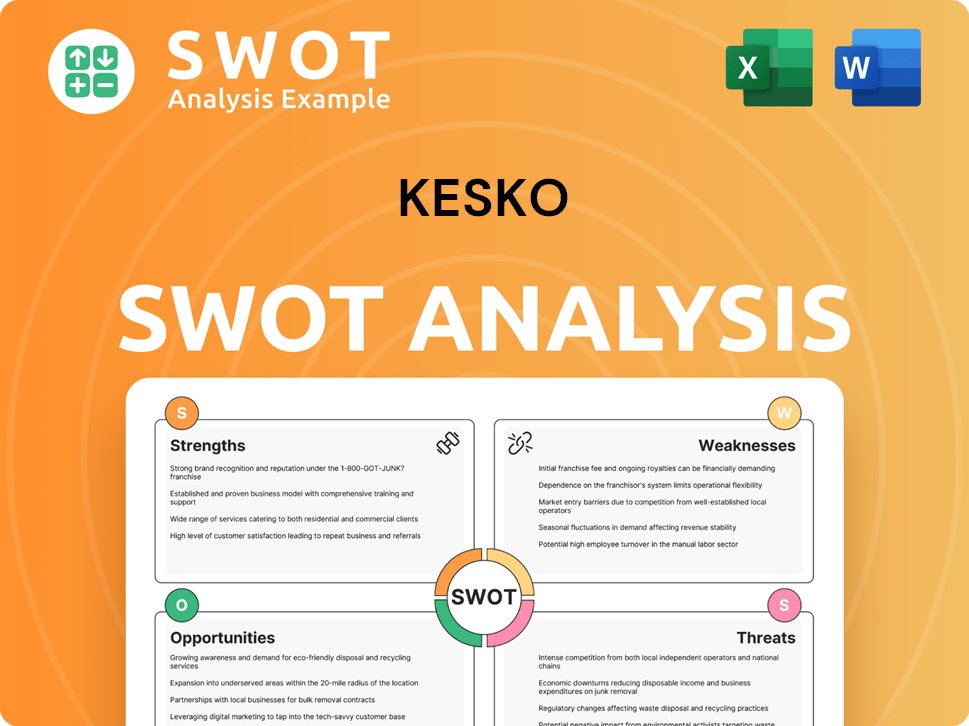
How Does Kesko Make Money?
The Kesko company generates revenue through three main business divisions: grocery trade, building and technical trade, and car trade. This diversified approach allows Kesko's business to capture various market segments and adapt to economic fluctuations. Kesko operations are designed to leverage synergies between these divisions, enhancing overall profitability and market presence.
Kesko's monetization strategies involve a combination of sales from physical stores, online channels, and services. The company focuses on strategic pricing, network investments, and digital services to boost sales and improve customer experiences. Kesko's commitment to innovation and customer satisfaction is central to its financial performance.
In 2024, Kesko's full-year net sales reached €11,920.1 million. The company's comparable operating profit for 2024 was €650.1 million. Kesko's focus on digital services and artificial intelligence is aimed at driving sales growth and improving efficiency.
The grocery trade division is a significant contributor to Kesko's revenue. In 2024, net sales reached €6,381.4 million, marking a 0.5% increase. This division includes grocery stores like K-Citymarket, K-Supermarket, and K-Market.
Monetization strategies include systematic price programs and investments in the store network. Online grocery sales are also a growing revenue stream. In Q1 2025, online grocery sales showed a 5.6% growth.
The building and technical trade division generated €4,351.6 million in net sales in 2024, up by 3.8%. Revenue comes from building materials, home improvement products, and technical trade offerings. The Davidsen acquisition in Denmark contributed to this growth.
Revenue is derived from sales to both B2C and B2B customers. Despite a decline in construction activity, the division maintained good profitability in 2024.
The car trade division's net sales in 2024 were €1,209.4 million, a decrease of 4.0%. Revenue includes new and used car sales and car-related services. Despite weak demand for new cars, profitability remained good in 2024.
In Q1 2025, car trade net sales increased to €313.9 million. This growth was supported by increased sales of new and used cars and services.
Kesko's approach to revenue generation involves strategic investments and operational efficiencies. The company uses a multi-faceted strategy to maximize profitability and market share. For more insights, check out the Marketing Strategy of Kesko.
- Systematic price programs to maintain competitiveness.
- Investments in store networks and online platforms.
- Focus on digital services and AI to enhance customer experience and efficiency.
- Diversification across grocery, building and technical trade, and car trade.
Kesko PESTLE Analysis
- Covers All 6 PESTLE Categories
- No Research Needed – Save Hours of Work
- Built by Experts, Trusted by Consultants
- Instant Download, Ready to Use
- 100% Editable, Fully Customizable
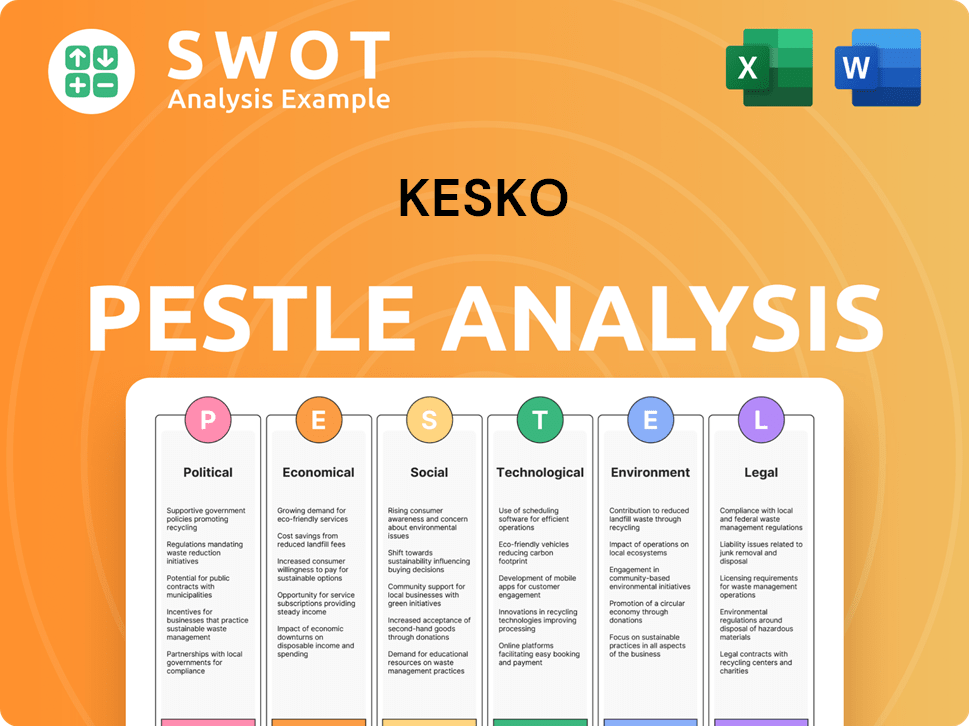
Which Strategic Decisions Have Shaped Kesko’s Business Model?
The Kesko company has strategically navigated the retail landscape, achieving significant milestones and adapting to market dynamics. Its operations are structured around three core divisions: grocery trade, building and technical trade, and car trade. This structure allows for focused development and competitive advantages within each sector.
Kesko's strategic moves and financial performance reflect its commitment to growth and sustainability. The company has expanded its market presence through acquisitions and investments in digital services. Despite facing operational challenges, Kesko has demonstrated resilience, with its Q4 results in 2024 showing improvement after eight consecutive quarters of decline. This reflects strategic adjustments and market adaptations.
The company's competitive edge is further strengthened by its sustainability initiatives and strong brand presence. Kesko's focus on sustainability has earned it consistent recognition, including top rankings in its peer group. By investing in digital services and store network enhancements, Kesko aims to improve customer experience and drive sales growth across its business segments.
In June 2024, Kesko updated its strategy, reinforcing its commitment to profitable growth across its divisions. The company expanded its operations in Denmark with the acquisition of Davidsen in 2024 and Roslev Trælasthandel A/S in January 2025, enhancing its market position in Northern Europe. Autotalo Lohja was acquired in 2024, strengthening the car dealership network in Southern Finland.
Kesko's strategic moves include acquisitions aimed at geographical expansion and strengthening its market position. Investments in digital services and AI are designed to drive sales growth and improve customer experience. The company continues to invest in its store network, with plans to remodel and open new stores in 2025.
Kesko's competitive advantages include a strong brand presence and extensive store network. The unique K-retailer business model in grocery trade combines centralized efficiency with local flexibility. Sustainability is a significant advantage, with consistent high rankings in global sustainability assessments.
Despite challenges such as a weak construction cycle and weak demand for new cars, Kesko's comparable operating profit for 2024 was €650.1 million. The company's Q4 results in 2024 showed improvement, indicating a turnaround. In 2024, 44 stores were remodeled and 15 new stores were opened. For 2025, plans include remodeling 48 stores and opening 15 new ones.
Kesko's strategic focus is on profitable growth in its core divisions, supported by acquisitions and digital investments. The company's sustainability efforts and strong brand presence provide a competitive edge. Kesko's financial performance reflects its ability to adapt to market challenges and capitalize on growth opportunities.
- Strategic acquisitions in Denmark and Finland.
- Investments in digital services and AI.
- Strong focus on sustainability and brand reputation.
- Comparable operating profit of €650.1 million in 2024.
Kesko Business Model Canvas
- Complete 9-Block Business Model Canvas
- Effortlessly Communicate Your Business Strategy
- Investor-Ready BMC Format
- 100% Editable and Customizable
- Clear and Structured Layout
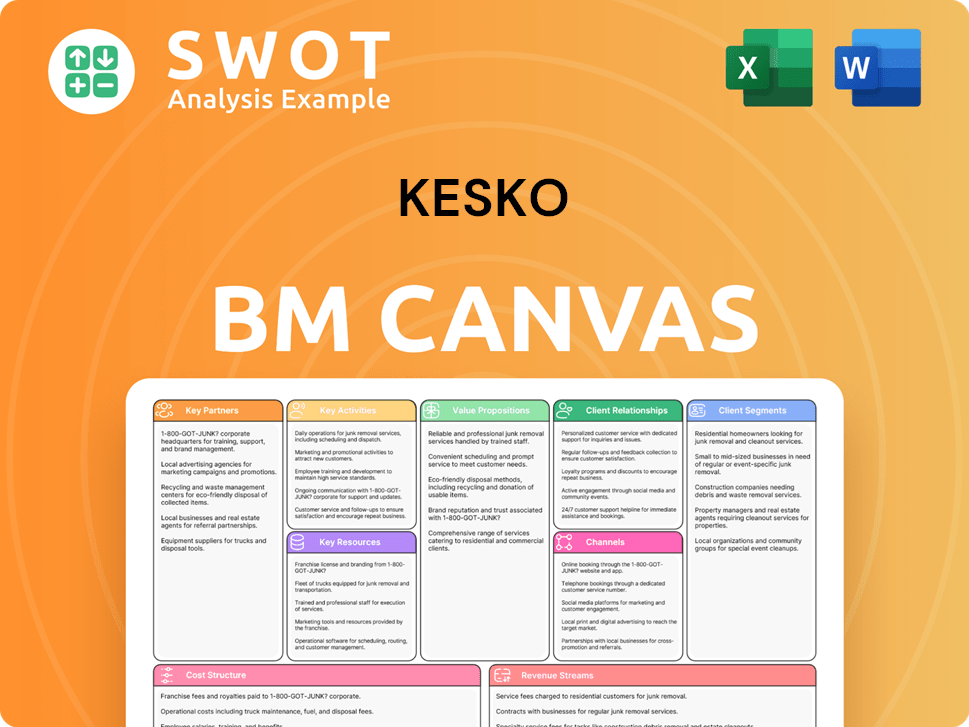
How Is Kesko Positioning Itself for Continued Success?
The Kesko company holds a prominent position in the industry, particularly as the largest trading sector operator in Finland. Operating as part of the K Group alongside K-retailers, Kesko business maintains a significant presence across Northern Europe. In 2024, the K Group's retail sales reached approximately €16 billion. This strong market position is supported by a diversified portfolio across grocery trade, building and technical trade, and car trade.
Despite its strengths, Kesko operations faces several risks and uncertainties. These include fluctuations in consumer confidence and investment appetites, which can impact demand across all business areas. Geopolitical events and regulatory changes also pose ongoing challenges. Weak construction activity and a decline in construction volumes in 2024 affected profitability in the building and technical trade, and the car trade division experienced weak demand for new cars.
As the largest trading sector operator in Finland, Kesko forms the K Group with K-retailers. This structure allows for localized offerings and strong customer relationships. Kesko's extensive network includes around 1,700 stores, with growing online sales capabilities, enhancing its market reach and customer service.
Consumer confidence and investment appetites can significantly impact demand. Weak construction activity and declining volumes in 2024 affected profitability. The car trade division also faced weak demand for new cars. Regulatory changes, new competitors, and changing consumer preferences are ongoing risks to Kesko's operations.
Kesko anticipates a gradually improving economic cycle in 2025 across all operating countries. The company estimates its comparable operating profit for 2025 to be in the range of €640-740 million. Strategic initiatives focus on revenue generation, including store network development and digital service enhancement.
Key focus areas for 2024-2026 include strengthening store-specific business ideas and improving price competitiveness. Kesko plans to invest an average of €200-250 million annually in store updates and new stores. The company aims to leverage digital services and artificial intelligence to drive sales growth and improve efficiency. For more details on the growth strategy of Kesko, see this article.
Kesko Porter's Five Forces Analysis
- Covers All 5 Competitive Forces in Detail
- Structured for Consultants, Students, and Founders
- 100% Editable in Microsoft Word & Excel
- Instant Digital Download – Use Immediately
- Compatible with Mac & PC – Fully Unlocked
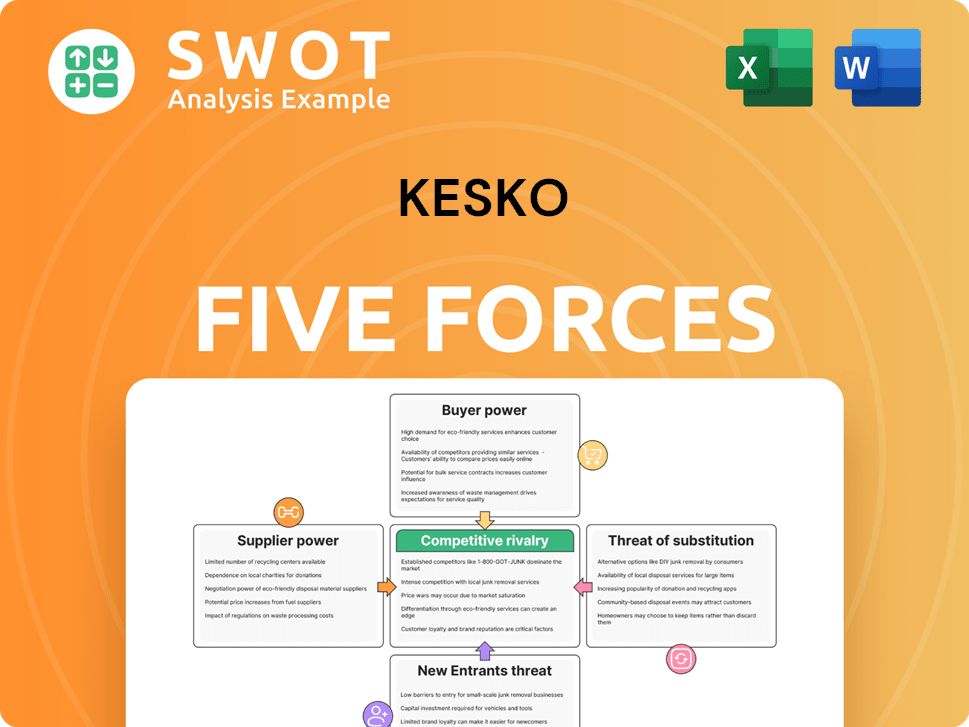
Related Blogs
- What are Mission Vision & Core Values of Kesko Company?
- What is Competitive Landscape of Kesko Company?
- What is Growth Strategy and Future Prospects of Kesko Company?
- What is Sales and Marketing Strategy of Kesko Company?
- What is Brief History of Kesko Company?
- Who Owns Kesko Company?
- What is Customer Demographics and Target Market of Kesko Company?
Disclaimer
All information, articles, and product details provided on this website are for general informational and educational purposes only. We do not claim any ownership over, nor do we intend to infringe upon, any trademarks, copyrights, logos, brand names, or other intellectual property mentioned or depicted on this site. Such intellectual property remains the property of its respective owners, and any references here are made solely for identification or informational purposes, without implying any affiliation, endorsement, or partnership.
We make no representations or warranties, express or implied, regarding the accuracy, completeness, or suitability of any content or products presented. Nothing on this website should be construed as legal, tax, investment, financial, medical, or other professional advice. In addition, no part of this site—including articles or product references—constitutes a solicitation, recommendation, endorsement, advertisement, or offer to buy or sell any securities, franchises, or other financial instruments, particularly in jurisdictions where such activity would be unlawful.
All content is of a general nature and may not address the specific circumstances of any individual or entity. It is not a substitute for professional advice or services. Any actions you take based on the information provided here are strictly at your own risk. You accept full responsibility for any decisions or outcomes arising from your use of this website and agree to release us from any liability in connection with your use of, or reliance upon, the content or products found herein.